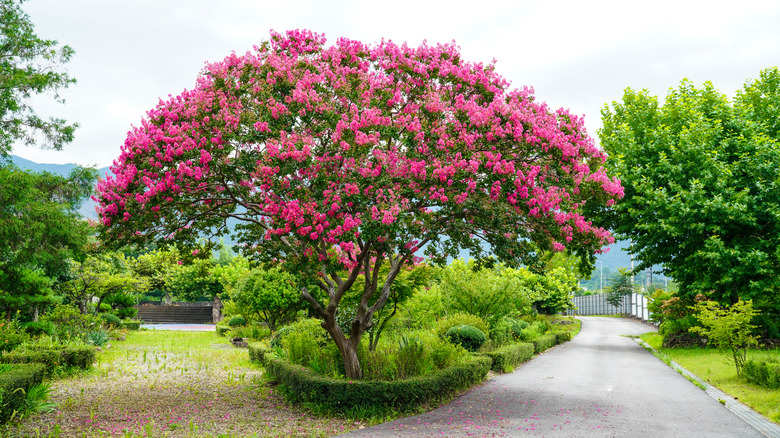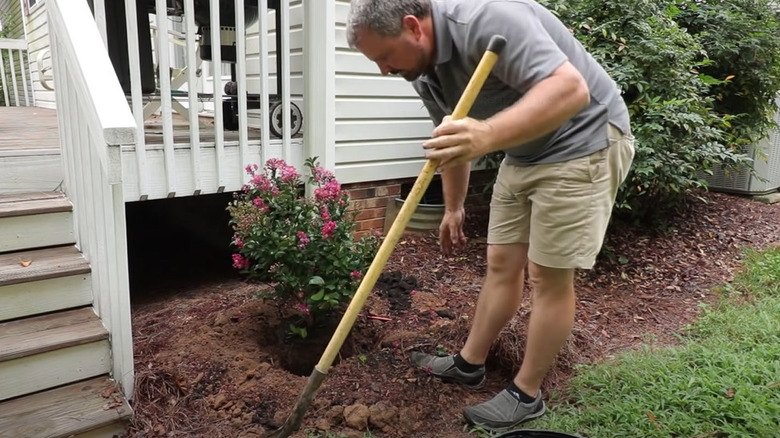When To Transplant Your Crepe Myrtle & The Biggest Mistakes To Avoid
The crepe myrtle is a star in the world of flora, with its captivating red and white blooms painting nature's canvas with vibrance. Not just a sight to behold, these gems also boast a host of medicinal perks. Imagine a tree flower with healing powers once boiled, providing soothing relief to burns or cuts. Yes, that's your crepe myrtle bloom. But sometimes, you must make tough decisions for those you care about. Similarly, there may come a time when transplanting your favorite crepe myrtle becomes necessary, primarily when it's about an environment better suited to its needs. So, when should you transplant a crepe myrtle? You'll want to undertake this adventure when your green companion is in its dormancy stage, which typically stretches from the end of winter to early spring.
Signs that the crepe myrtle might be longing for a new habitat include limited sunlight and space for root growth and when utility or power lines intimidate the plant's blissful spread. However, time alone can't guarantee a successful transplant— several little details could make a world of difference. While mistakes are inevitable, some could lead to disastrous results. Whether it's insufficient site preparation, incorrect handling of the crepe myrtle's root ball, or subpar post-transplant care, each can compromise your tree's survival. Next, let's dive into the dodge-worthy pitfalls and practical tips to ensure your crepe myrtle transplantation is a triumphant endeavor.
Best time to transplant your crepe myrtle
Timing in gardening doesn't get any more real than when you're about to transplant a crepe myrtle. The golden rule here is to wait for the dormancy period. This phase masterfully slows down the tree's growth, giving your crepe myrtle a commendable edge to settle in its new home with minimal translocation stress. You'll be surprised to learn that the timing of tree transplantation is entirely distinct from that of the original planting. Although the thrill of initial planting knows no bounds on the calendar, transplanting demands tactful scheduling to ensure your plant flourishes as intended.
It's about getting comfortable with the tree's growth cycle. From spring to summer, crepe myrtles are at their prime, consuming available resources to fuel their growth's voracity. Clever as they are, they retreat into dormancy during winter, with their nutrition and hydration needs taking a nosedive. Thankfully, this means less susceptibility to the dreaded crepe myrtle transplant shock. It's during this spell that your tree manages to store enough energy, thus preparing itself for life in a new space.
Transplanting a crepe myrtle in summer is a giant no-no, as the possibility of it falling victim to transplant shock is alarmingly high. Age matters, too. Whether a venerable old giant or a sprightly young sapling, every tree is braced for the jolt of moving pains. But here's the clincher: younger crepe myrtles, with their roaring growth rates, could race to recovery way faster than their older peers.
Mistakes to avoid when transplanting your crepe myrtle
Insufficient plant preparation ranks among the most prominent crepe myrtle tree transplanting mistakes. You don't want to treat your crepe myrtle like last-minute grocery shopping. Thoroughly water it a few days ahead of transplanting to retain the root ball and minimize transplant shock. And don't forget to give the tree a good pruning, prioritizing dead or diseased branches. This will shrink the tree's size, making it easier to handle.
Now, onto the second big mistake when transplanting a crepe myrtle: poor site selection. Imagine going for a vacation and finding out your hotel room looks out at a waste dump — talk about a holiday spirit dampener. Similarly, any location with limited sun or space or too close to structures like poles, porches, decks, driveways, or fences is a strict no-no for a crepe myrtle. Yet, don't skimp on the transplant site preparation. Ensure the planting hole is as deep and twice as broad as the root ball. Be extra careful when handling the root ball, and enlist a few friends to aid with the transfer.
It's not only about the shift though, but also the aftercare. Poor post-transplant care is like buying a new pet and leaving it to catch its food. Your crepe myrtle requires intensive care after it's moved until it adjusts. That comprises regular and deep watering, though not to the point of drowning it. And don't forget the mulch — it's your plant's shield against drying out.


